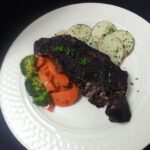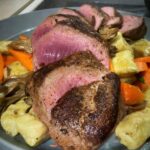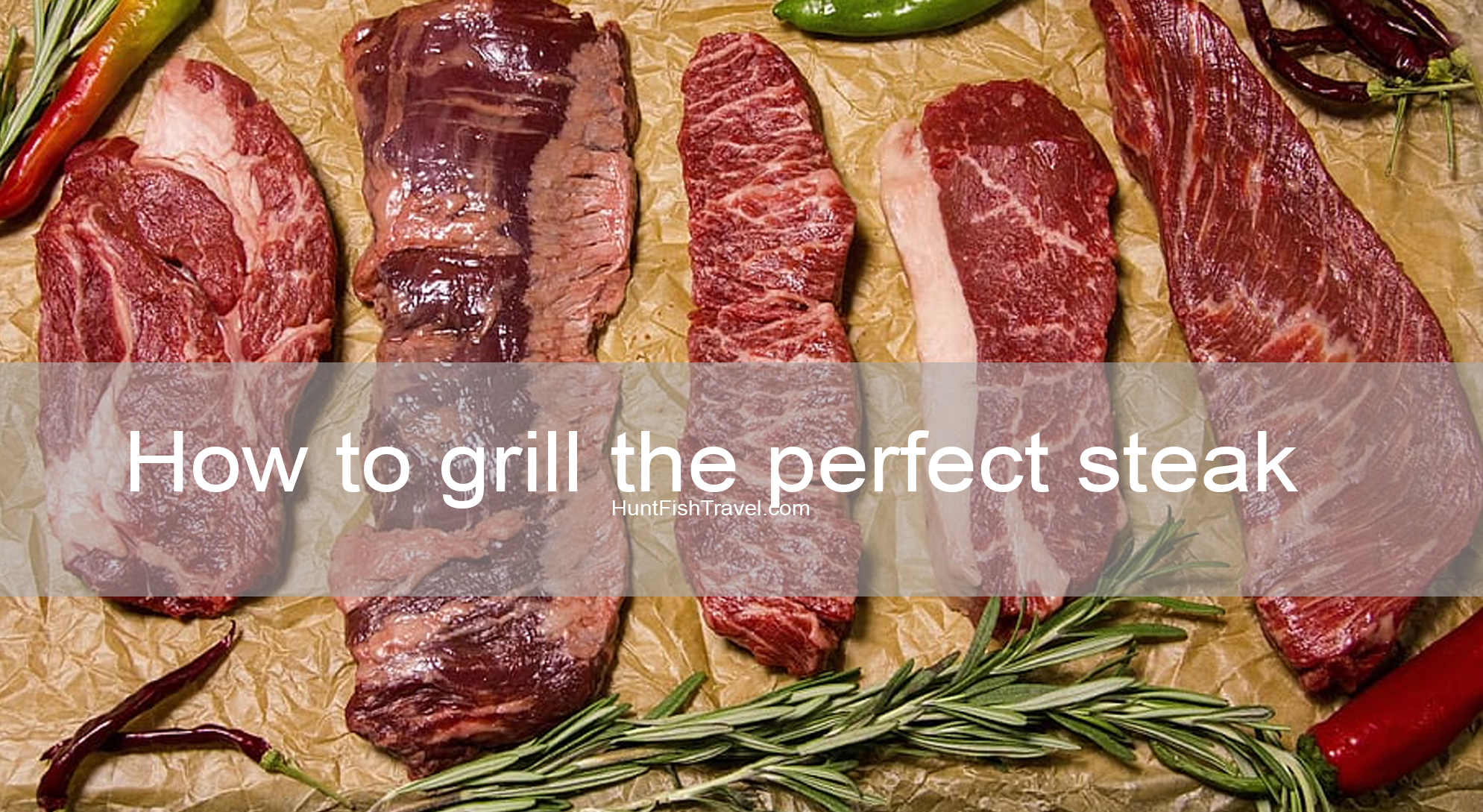We’ve all been there: buyer’s remorse.
We have big plans for cooking the best steak ever out on the grill. You thought you cooked it perfectly, and it would be delicious, with your family applauding you on making the best steak ever! Then you take that first bite. It’s tough. It’s flavorless. And sadly, most of it ends up in the garbage can soon after dinner. Disappointment at its finest. Did you screw it up? Or did your steak just suck? Well, let us take a few minutes to figure it out and see if I can help you make the most of your grilling experience.
 Choosing the Right Cut
Choosing the Right Cut
In the world of beef steaks, there is definitely no shortage of different cuts. They all have their own flavors, textures, and ways they need to be cooked. First things first in cooking the perfect steak – finding one that matches what you want to do with it and what you like about a steak. So let’s look at the common cuts of meat and figure out the problem.
Tenderloin
 Everyone’s favorite, right? Well, it isn’t mine. Not for grilling anyways. But if you are hell-bent on having tenderloin with your grilled lobster tail, let’s have a look. Tenderloin comes from inside the body cavity of the cow, pig, deer, whatever animal you took it from. It is a non-working muscle, which means it isn’t used by the animal for any real heavy work. That keeps this cut very tender, which is the big selling point of this cut. “You could cut it with a fork,” I have heard numerous times. It really does lend itself well to searing, but grilling? Here are the cons.
Everyone’s favorite, right? Well, it isn’t mine. Not for grilling anyways. But if you are hell-bent on having tenderloin with your grilled lobster tail, let’s have a look. Tenderloin comes from inside the body cavity of the cow, pig, deer, whatever animal you took it from. It is a non-working muscle, which means it isn’t used by the animal for any real heavy work. That keeps this cut very tender, which is the big selling point of this cut. “You could cut it with a fork,” I have heard numerous times. It really does lend itself well to searing, but grilling? Here are the cons.
Tenderloin is a very lean cut of meat. This can cause a few different problems when cooking. The big one, and I will mention this a few times in this article, is the old adage, “fat equals flavor.” While this cut is tender, the level of flavor is low. This is why most of the time you order it at a restaurant, it comes with a sauce. High-end places use sauces such as Demi-glacé to add flavor where there is none. So if you want a flavorful steak, there are much better options. But if tender is your only wish, then you could do worse than this cut.
Being such a lean cut, it is best cooked rare or at most medium-rare. Anything more and you cook any flavor out of it. It also becomes tougher the longer it is cooked. I find anything over medium, especially without a sauce, is really only fit for the dog. I jest though. I wouldn’t feed it to my dog either. If you spend good money on a tenderloin (they aren’t cheap), you should at least maximize everything you can about it. I personally cook all my tenderloins to a blue rare. What is blue rare you ask? Well, imagine ordering a rare steak and having it come out undercooked. This maximizes the most amount of flavor with this cut and, in my opinion, is the best way to enjoy it.
Cook on direct high heat on your grill to get a nice char and grill marks on both sides. Bring the internal temperature up to about 115 degrees, using a probe thermometer in the center of the steak. The trick is to let the steak rest for the same time you let it cook. If you had your steak cook for 10 minutes, 5 on each side, then you will want to rest it for 10 minutes. This gives the steak a chance to redistribute its juices properly, giving you a juicier, more flavorful steak. Being such a lean cut, with very little in the way of moisture, doing the little things like resting the meat really pays dividends.
Ribeye
While cuts like tenderloin, t-bone, porterhouse, and strips get everyone’s attention, the ribeye is where it’s at when it comes to grilling. Remember earlier when I mentioned fat equals flavor? This is where the flavor is at. You really have to pay attention to what you buy though. This can be one of the best cuts of steak, or barely worth cooking into fajitas or something. First, pick yourself up a good steak from a reputable butcher. Those Walmart ribeyes won’t cut it. Trust me when I say you will see where the extra $10/lb goes.
Ribeyes have an excellent fat-to-meat ratio, but all that fat means you need to cook it differently. To make the most out of all the flavor in a ribeye, you must first get the intramuscular fat to start to render and caramelize. The intramuscular fat is the marbling of fat that runs through the meat. The best temperature to cook a ribeye is medium-rare to medium. This ensures the fat is starting to render, distributing the most amount of flavor through the meat. Undercook, and the fat won’t render, so you will be left with a less flavorful cut of meat, and it will have a raw, unappealing texture and mouth feel. An overcooked (past medium) steak will lose most of its fat content and, with it, most of the flavor. It will be tougher and really a waste of such a great cut.
Porterhouse/T-bone
 The king of steaks. The biggest, manliest cut there is – the go-to for any real steak eater, right? Okay, everyone likes the T-bone, probably because it really fills your plate and makes you feel like you have a bigger meal than that little tenderloin you get. Your eyes will judge a steak before your mouth, and just that sight of that plateful of deliciousness really sends your taste buds into a frenzy. But what is this marvel of the culinary world? Well, you pretty much have a tenderloin, a strip steak, and a big-ass bone. As we discussed earlier, tenderloin is a favorite amongst steak eaters, and the number 2 has always been the strip steak. Both cuts are very lean and very tender. Not much intramuscular fat though, tending to make them a little less flavorful. It also is a little trickier to grill. But if you nail it, it’s great.
The king of steaks. The biggest, manliest cut there is – the go-to for any real steak eater, right? Okay, everyone likes the T-bone, probably because it really fills your plate and makes you feel like you have a bigger meal than that little tenderloin you get. Your eyes will judge a steak before your mouth, and just that sight of that plateful of deliciousness really sends your taste buds into a frenzy. But what is this marvel of the culinary world? Well, you pretty much have a tenderloin, a strip steak, and a big-ass bone. As we discussed earlier, tenderloin is a favorite amongst steak eaters, and the number 2 has always been the strip steak. Both cuts are very lean and very tender. Not much intramuscular fat though, tending to make them a little less flavorful. It also is a little trickier to grill. But if you nail it, it’s great.
Now with this steak being a combo of such lean cuts, you don’t want to overcook it. But you also need to ensure it cooks properly along the bone. The bone really helps shield the meat from the heat. This means the meat along the bone will cook slower than the rest of the steak. But it also helps add flavor to the meat that is lacking in the deboned cuts of tenderloin and strip steak.
I tend to cook this cut to medium. I cook it under direct heat on my grill to get good caramelization and grill marks on the meat, then I will transfer it to indirect heat to finish the cooking process, until it reaches an internal temperature of 125. Just like all steaks, resting is imperative.
Sirloin
 Sirloin is a great all-purpose steak. It is lean but not as lean as tenderloin or strip. It has some intramuscular fat, but not nearly as much as the ribeye has. It is about middle of the road in flavor. It lends itself to all sorts of purposes: grilling into steak, thinly sliced for fajitas or kabobs on the grill, really whatever you want to do with it. It is a more cost-efficient cut, giving you the opportunity to get more steak for your buck. But watch out, not all sirloins are created equal. A cheap sirloin will undoubtedly be tough and better for slow cooking. If you want a good steak to grill out, spend the money and get a good butcher shop steak.
Sirloin is a great all-purpose steak. It is lean but not as lean as tenderloin or strip. It has some intramuscular fat, but not nearly as much as the ribeye has. It is about middle of the road in flavor. It lends itself to all sorts of purposes: grilling into steak, thinly sliced for fajitas or kabobs on the grill, really whatever you want to do with it. It is a more cost-efficient cut, giving you the opportunity to get more steak for your buck. But watch out, not all sirloins are created equal. A cheap sirloin will undoubtedly be tough and better for slow cooking. If you want a good steak to grill out, spend the money and get a good butcher shop steak.
Flank Steak
Over the past decade or two, the flank steak has really taken off in popularity. This cut is thin and cooks quickly. The best grill use I have for flank is that it makes a great grilled fajita. This isn’t one of those cuts you want to have on the grill when a big thick steak is what you’re craving. It should be grilled fast and hard. I personally like to use a marinade on it to add more flavor. I will put it on my grill in the hottest spot I can find for a minute on each side to give it a good char. Then I usually finish the meat up on a screaming hot cast iron skillet. With a good marinade and a fast, hard cook, you can cook this over a temperature of medium and retain lots of flavor and tenderness.
I hope some of these steak grilling tips come in handy for you this summer. I know mine will be filled with the scent and sizzle of good meat. After all, what is summertime without a bunch of meat on a charcoal grill! Happy eating, y’all!
Discover more from The HuntFishTravel Show
Subscribe to get the latest posts sent to your email.


